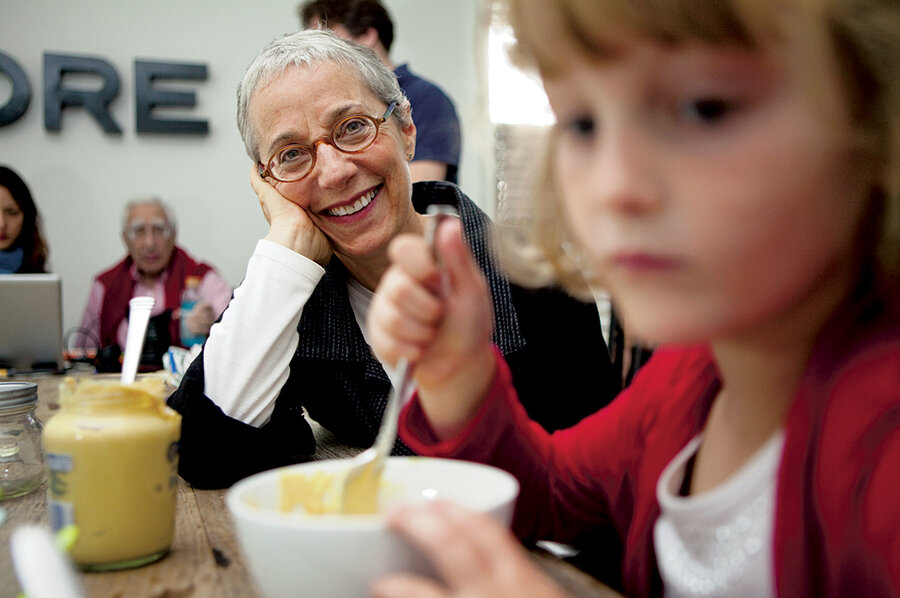Sally Sampson makes cooking fun to fight childhood obesity
Loading...
| Watertown, Mass.
At a stylish house in Watertown, Mass., with high ceilings and stained-wood floors, children gather in a gleaming white kitchen. Dressed in colorful clothes they are testing spicy foods – and making faces.
"Not so much, Dylan!" cries Rahma, age 7, her dark hair spilling over her shoulders as she inspects her friend's handiwork in adding hot sesame oil to a bowl of mustard.
A photographer and food stylist hover in the background, trying to capture the aesthetic of the moment for the winter issue of ChopChop, a cooking magazine for families with young children, which will feature international soups and spices.
In just three years, ChopChop's founder, Sally Sampson, has done something remarkable. She began with a simple idea – recipes easy enough for kids to make. Then she pooled the talents and resources of her friends, secured funding, created an ad-free magazine that now is distributed to half of all pediatricians' offices in the United States, launched a website (www.chopchopmag.org), visited the White House, published a cookbook, and won awards from the James Beard Foundation and Parents' Choice.
Her mission: Eliminate obesity by helping kids learn that cooking is cool. But "don't demonize food," Ms. Sampson says. "Don't even mention 'obesity' to kids."
Statistics on childhood obesity have fueled discussions from school board meetings to the White House. About 1 in 8 preschoolers (12.5 percent) in the US is obese, according to the Centers for Disease Control and Prevention. Those numbers increase among minority children, with 19 percent of black children and 16 percent of Hispanic children between the ages of 2 and 5 described as obese.
The culprit is often defined as too much access to sugary foods and drinks, and not enough physical play or understanding of the building blocks of a nutritious meal.
"No single thing is going to solve obesity on its own," says David Cutler, a health economist at Harvard University. But "ChopChop helps to reverse the thought that people don't know how to make things easy, cheap, and quick – that healthy food is harder to obtain" than fast food, he says.
In ChopChop, the food may be simple, but it's not all chocolate chip cookies and hidden vegetables. In fact, Sampson doesn't publish many dessert recipes because those are usually what most kids want to make. Instead the magazine features games, kitchen safety tips, and recipes such as the cold soba-noodle salad, raspberry lemonade, and sockeye-salmon salad in the fall issue – the kinds of dishes that could appeal to kids and parents alike. Cooking and eating together as a family affair is something Sampson strongly emphasizes.
Catrine Kelty, a food stylist who has worked with Sampson on her magazine and ChopChop cookbook, agrees that the sooner kids learn their way around the kitchen the better.
"Instill cooking in kids early enough, and they will cook their whole lives," she says.
Sampson got her start in food in her 20s when she opened a takeout shop in Brookline, Mass. Her soups were so popular that she published a cookbook of her recipes. That led to food writing and more cookbooks (22 in all). At home, as a parent of two, Sampson had to pay attention to her daughter's diet because of a chronic health issue. Years later, as her own interest in health-care solutions grew, Sampson had an idea that she still pursues: "I realized that I had the skills to tackle obesity, if I could just get doctors to prescribe cooking."
Her timing is impeccable – today more people are interested in making home-cooked meals with fresh ingredients. Cooking programs (including Fox's "MasterChef Junior") crowd the airwaves, and the White House has hosted two Kids' State Dinners based on recipes submitted by US children.
It's entirely coincidental, Sampson says. Before Michelle Obama launched her "Let's Move!" campaign in 2010, Sampson was already at work developing ChopChop. She single-handedly secured funding (primarily from New Balance, the shoe and clothing company) and sponsors, and orchestrated a photo shoot at the White House that featured Grover from "Sesame Street" and White House assistant chef Sam Kass. The Massachusetts governor's office also features ChopChop recipes in its monthly Mass in Motion newsletter.
ChopChop magazine, which publishes 500,000 copies four times a year (20 percent in Spanish), started out on a shoestring budget in a spare room in Sampson's house. The nonprofit, subscription-based publication has since moved into office space in Watertown, a Boston suburb.
Sampson is the only full-time staffer, working with eight part-time workers and a handful of interns. Many on her creative team first worked pro bono because of ChopChop's appealing mission and Sampson's passion and clarity of vision.
"Sally is a kind of force of nature," Dr. Cutler says. "She has just incredible energy. She is incredibly kind and very, very driven to make a difference....
"[The magazine] for the kids is fun. For the adults, you really feel like you are doing good. It's rare that you come across the combination of those two things," Cutler says.
Help feed the hungry
UniversalGiving helps people give to and volunteer for top-performing charitable organizations worldwide. Projects are vetted by Universal Giving; 100 percent of each donation goes directly to the listed cause.
Below are three groups selected by UniversalGiving that help to feed hungry people around the world:
• The What If? Foundation provides food and educational opportunities to impoverished children in Port-au-Prince, Haiti. Project: For $24, feed a child for a month.
• Solar Household Energy strives to unleash the potential of solar cooking for global health, economic development, and the environment around the world. Project: Support sun ovens in the Dominican Republic and Haiti.
• Miracles In Action’s mission is to provide Guatemalans living in extreme poverty with opportunities to help themselves through educational, vocational, and other sustainable development projects. Project: Donate pigs and chickens to provide income and food.






